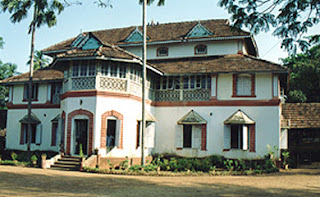Archaeological Museum Thrissur Kerala
History
Archaeological Museum situated in the city of Thrissur, Kerala, is a
part of the state zoo compound. The archaeological gallery was attached
to the already existing art gallery, in the year 1948. Later, the
galleries were shifted to a new building in the year 1975. With time,
the museum has accumulated a large collection of diverse artifacts. For
instance, it preserves a number of life size statues of famous and
eminent personalities like tribal chiefs, famous artists, kings, freedom
fighters and reformers etc. Highly detailed and intricately crafted
models of old buildings and temples are also conserved here and it also
preserves manuscripts from the past which contains the history of
Kerala.
These manuscripts exhibited in the Archaeological Museum Trichur are preserved with great care, as these are made of highly vulnerable dried palm leaves. The museum also stores a large number of artifacts, which were found from the jungles of Thrissur and Wayanad district. One of the major possessions of the Archaeological museum is a rare assortment of ‘Veerakallu’ or stone engravings and carvings, along with an atypical collection of megalithic weapons which were excavated from the forests of Wayanad and Thrissur. Other items which are showcased along with this exquisite collection include a gigantic anthology of Stone Age tools, megalithic wares and pottery, russet coated wares, urn burials, items excavated from north Indian civilizations like Harappa and Indus Valley Civilization. One can also find stone sculptures as old as 7th century and bronze sculptures dating back to the 10th century, here. Materials that have been excavated from Nenmeni Village, near Kollengode, are also displayed at the Archaeological Museum of Thrissur.
The building of Archaeological Museum Trichur was constructed by the king of Kollengode, for his daughter, in the year 1904. The building displays an exclusive merger of customary Kerala architecture and Western architecture. The history comes alive in the museum, in the form of paintings and sculptures. One can get a glimpse of the vibrancy of the culture, religion, performing arts, architecture and literature of the state, through these paintings and sculptures. The archaeologists regard this museum as one of the most accomplished museums in India, in terms of the accessibility to the artifacts and the typical diversity of those. The museum is home to the largest assortment of megalithic remains in Kerala. The environs of the museum are covered with thick vegetation that adds to the charm of the museum’s location. It is maintained and retained by the State Archaeology Department of Kerala.
These manuscripts exhibited in the Archaeological Museum Trichur are preserved with great care, as these are made of highly vulnerable dried palm leaves. The museum also stores a large number of artifacts, which were found from the jungles of Thrissur and Wayanad district. One of the major possessions of the Archaeological museum is a rare assortment of ‘Veerakallu’ or stone engravings and carvings, along with an atypical collection of megalithic weapons which were excavated from the forests of Wayanad and Thrissur. Other items which are showcased along with this exquisite collection include a gigantic anthology of Stone Age tools, megalithic wares and pottery, russet coated wares, urn burials, items excavated from north Indian civilizations like Harappa and Indus Valley Civilization. One can also find stone sculptures as old as 7th century and bronze sculptures dating back to the 10th century, here. Materials that have been excavated from Nenmeni Village, near Kollengode, are also displayed at the Archaeological Museum of Thrissur.
The building of Archaeological Museum Trichur was constructed by the king of Kollengode, for his daughter, in the year 1904. The building displays an exclusive merger of customary Kerala architecture and Western architecture. The history comes alive in the museum, in the form of paintings and sculptures. One can get a glimpse of the vibrancy of the culture, religion, performing arts, architecture and literature of the state, through these paintings and sculptures. The archaeologists regard this museum as one of the most accomplished museums in India, in terms of the accessibility to the artifacts and the typical diversity of those. The museum is home to the largest assortment of megalithic remains in Kerala. The environs of the museum are covered with thick vegetation that adds to the charm of the museum’s location. It is maintained and retained by the State Archaeology Department of Kerala.




No comments:
Post a Comment